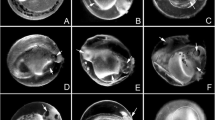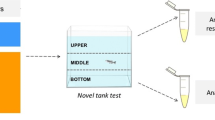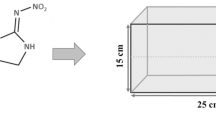Abstract
Assessment of pesticides toxicity using zebrafish early life stages is relevant for aquatic systems safety. This study aimed to evaluate the short-term effects of 2,4-dichlorophenoxyacetic acid (2,4-D) on zebrafish (Danio rerio) embryos from 3 h post fertilization to 96 hpf. A set of 2,4-D concentrations ranging from 0.32 to 80 mg/L were tested and median lethal concentration (LC50) at 96-h was calculated as 2.86 mg/L. A sub-teratogenic concentrations range from 0.02 to 0.8 mg/L was then used to assess effects at ontogenic, biochemical, and behavioral levels. The main developmental defects were tail deformities and pericardial edema at concentrations equal or above 0.32 mg/L. Cholinesterase activity (at 96 hpf) and larvae swimming behavior (at 120 hpf) were affected even at the lowest tested dose (0.02 mg/L). The behavior analysis was a sensitive endpoint, with a decrease in the swimming distance of exposed larvae during light period. The effect of 2,4-D in ChE was translated by an inhibition of the enzyme activity in all treated groups. These findings demonstrate that 2,4-D can alter the cholinergic system by affecting ChE activity which may be involved in the locomotion reduction of exposed larvae and emphasize the potential of neurotransmission and behavioral endpoints as early warning signs of herbicides contamination in aquatic ecosystems.




Similar content being viewed by others
References
Ahmad F, Noldus LPJJ, Tegelenbosch RAJ, Richardson MK (2012) Zebrafish embryos and larvae in behavioural assays. Behaviour 149:1241–1281. https://doi.org/10.1163/1568539X-00003020
Altenhofen S, Wiprich MT, Nery LR, Leite CE, Vianna MR, Bonan CD (2017) Manganese(II) chloride alters behavioral and neurochemical parameters in larvae and adult zebrafish. Aquat Toxicol 182:172–183. https://doi.org/10.1016/j.aquatox.2016.11.013
Andrade TS, Henriques JF, Almeida AR, Machado AL, Koba O, Giang PT, Soares AMVM, Domingues I (2016) Carbendazim exposure induces developmental, biochemical and behavioural disturbance in zebrafish embryos. Aquat Toxicol 170:390–399. https://doi.org/10.1016/j.aquatox.2015.11.017
Arivu I, Muniyan M, Muthulingam M, Parthiban P, Ambedkar G, Kamalkanth S (2015) Toxicity of 2,4-Dichlorophenoxyacetic acid on freshwater fingerlings Labeo Rohita (Hamilton). World J Pharm Pharm Sci 4:1173–1190
Atamaniuk TM, Kubrak OI, Storey KB, Lushchak VI (2013) Oxidative stress as a mechanism for toxicity of 2,4-dichlorophenoxyacetic acid (2,4-D): studies with goldfish gills. Ecotoxicology 22:1498–1508. https://doi.org/10.1007/s10646-013-1136-z
Bailey J, Oliveri A, Levin ED (2013) Zebrafish model systems for developmental neurobehavioral toxicology. Birth Defects Res C Embryo Today 99(1):14–23. https://doi.org/10.1002/bdrc.21027
Ben Salem F, Ben Said O, Aissa P, Mahmoudi E, Monperrus M, Grunberger O, Duran R (2016) Pesticides in Ichkeul Lake–Bizerta LagoonWatershed in Tunisia: use, occurrence, and effects on bacteria and free-living marine nematodes. Environ Sci Pollut Res 23(1):36–48. https://doi.org/10.1007/s11356-015-4991-8
Benli ACK, Sarikaya R, Sepici-Dincel A, Selvi M, Sahin D, Erkoc- F (2007) Investigation of acute toxicity of (2,4-dichlorophenoxy) acetic acid (2,4-D) herbicide on crayfish (Astacus leptodactylus Esch. 1823). Pestic Biochem Physiol 88:296–299. https://doi.org/10.1016/j.pestbp.2007.01.004
Borges S, Dzubow C, Orrick G, Stavola A (2004) 2,4-Dichlorophenoxyacetic acid analysis of risks to endangered and threatened salmon and steelhead. Environmental Field Branch Office of Pesticide Programs, USA
Bradford M (1976) A rapid and sensitive method for the quantification of microgram quantities of protein utilizing the principle of protein dye-binding. Anal Biochem 72:248–254
Browne AM, Moore PA (2014) The effects of sublethal levels of 2,4 dichlorophenoxyacetic acid herbicide (2,4-D) on feeding behaviors of the crayfish O. rusticus. Arch Environ Contam Toxicol 67:234–244
Cao FJ, Liu XS, Wang CJ, Zheng MQ, Li XF, Qiu LH (2016) Acute and short term developmental toxicity of cyhalofop-butyl to zebrafish (Danio rerio). Environ Sci Pollut Res 23:10080–10089. https://doi.org/10.1007/s11356-016-6236-x
Chen Q, Yu L, Yang L, Zhou B (2012) Bioconcentration and metabolism of decabromodiphenyl ether (BDE-209) result in thyroid endocrine disruption in zebrafish larvae. Aquat Toxicol 110-111(110):141–148. https://doi.org/10.1016/j.aquatox.2012.01.008
Colón-Cruz L, Kristofco L, Crooke-Rosado J, Acevedo A, Torrado A, Brooks BW, Sosa MA, Behra M (2018) Alterations of larval photo-dependent swimming responses (PDR): new endpoints for rapid and diagnostic screening of aquatic contamination. Ecotoxicol Environ Saf 147:670–680
Colwill RM, Creton R (2011) Locomotor behaviors in zebrafish (Danio rerio) larvae. Behav Process 86:222–229. https://doi.org/10.1016/j.beproc.2010.12.003
De Gaspar I, Blanquez MJ, Fraile B, Paniagua R, Arenas MI (1999) The hatching gland cells of trout embryos: characterisation of N- and Olinked oligosaccharides. J Anat 194:109–118
Domingues I, Oliveira R, Lourenço J, Grisolia CK, Mendo S, Soares AMVM (2010) Biomarkers as a tool to assess effects of chromium (VI): comparison of responses in zebrafish early life stages and adults. Comp Biochem Physiol C Toxicol Pharmacol 152(3):338–345
Eissa BL, Ossana NA, Ferrari L, Salibian A (2010) Quantitative behavioral parameters as toxicity biomarkers: fish responses to waterborne cadmium. Arch Environ Contam Toxicol 58:1032–1039
Ellman GL, Courtney KD, Andres V Jr, Featherstone RM (1961) A new and rapid colorimetric determination of acetylcholinesterase activity. Biochem Pharmacol 7:88–95
Farah MA, Ateeq B, Ali MN, Sabir R, Ahmad W (2004) Studies on lethal concentrations and toxicity stress of some xenobiotics on aquatic organisms. Chemosphere 55:257–265
Félix LM, Antunes LM, Coimbra AM, Valentim AM (2017) Behavioral alterations of zebrafish larvae after early embryonic exposure to ketamine. Psychopharmacology 234(4):549–558. https://doi.org/10.1007/s00213-016-4491-7
Fent K, Meier W (1992) Tributyltin-induced effects on early life stages of minnows Phoxinusphoxinus. Arch Environ Contam Toxicol 22:428–438
Fonseca MB, Glusczak L, Moraes BS, Menezes CC, Pretto A, Tierno MA, Zanella R, Gonçalves FF, Loro VL (2008) The 2,4-D herbicide effects on acetylcholinesterase activity and metabolic parameters of piava freshwater fish (Leporinus obtusidens). Ecotoxicol Environ Saf 69:416–420. https://doi.org/10.1016/j.ecoenv.2007.08.006
Gerhardt A (2007) Aquatic behavioral ecotoxicology prospects and limitations. Hum Ecol Risk Assess Int J 13:481–491
Gonzalez ST, Remick D, Creton R, Colwill RM (2016) Effects of embryonic exposure to polychlorinated biphenyls (PCBs) on anxiety-related behaviors in larval zebrafish. Neurotoxicology 642(53):93–101
Guerrero-Estévez SM, López-López E (2016) Effects of endocrine disruptors on reproduction in viviparous teleosts with intraluminal gestation. Rev Fish Biol Fish 26:563–587
Howard PHE (1991) 2,4-D. Handbook of environmental fate and exposure data for organic chemicals. Lewis, Chelsea, pp 145–156
Irons TD, MacPhail RC, Hunter DL, Padilla S (2010) Acute neuroactive drug exposures alter locomotor activity in larval zebrafish. Neurotoxicol Teratol 32:84–90
** M, Zhang X, Wang L, Huang C, Zhang Y, Zhao M (2009) Developmental toxicity of bifenthrin in embryo-larval stages of zebrafish. Aquat Toxicol 95:347–354
** Y, Liu Z, Fang L, Yang Y, Tao P, Fu Z (2015) Embryonic exposure to cadmium (ii) and chromium (vi) induce behavioral alterations, oxidative stress and immunotoxicity in zebrafish (Danio rerio). Neurotoxicol Teratol 48:9–17
Kalueff AV, Gebhardt M, Stewart AM, Cachat JM, Brimmer M, Chawla JS, Craddock C, Kyzar EJ, Roth A, Landsman S, Gaikwad S, Robinson K, Baatrup E, Tierney K, Shamchuk A, Norton W, Miller N, Nicolson T, Braubach O, Gilman CP, Pittman J, Rosemberg DB, Gerlai R, Echevarria D, Lamb E, Neuhauss SC, Weng W, Bally-Cuif L, Schneider H (2013) Towards a comprehensive catalog of zebrafish behavior 1.0 and beyond. Zebrafish 10:70–86. https://doi.org/10.1089/zeb.2012.0861
Kane AS, Salierno JD, Gipson GT, Molteno TC, Hunter C (2004) A video-based movement analysis system to quantify behavioral stress responses of fish. Water Res 38:3993–4001
Kimmel CB, Patterson J, Kimmel RO (1974) The development and behavioral characteristics of the startle response in the zebrafish. Dev Psychobiol 7:47–60
Kubrak OI, Atamaniuk TM, Storey KB, Lushchak VI (2013) Goldfish can recover after short-term exposure to 2,4-dichlorophenoxyacetate: use of blood parameters as vital biomarkers. Comp Biochem Physiol C 157(3):259–265
Kuster E, Altenburger R (2007) Suborganismic and organismic effects of aldicarb and its metabolite aldicarb-sulfoxide to the zebrafish embryo (Danio rerio). Chemosphere 68:751–760
Li K, Wu JQ, Jiang LL, Shen LZ, Li JY, He ZH, Wei P, Lv Z, He MF (2017) Developmental toxicity of 2,4-dichlorophenoxyacetic acid in zebrafish embryos. Chemosphere 171:40–48. https://doi.org/10.1016/j.chemosphere.2016.12.032
Little EE, Archeski RD, Flerov BA, Kozlovskaya VI (1990) Behavioral indicators of sublethal toxicity in rainbow trout. Arch Environ Contam Toxicol 19:380–385
Matviishyn TM, Kubrak OI, Husak VV, Storey KB, Lushchak VI (2014) Tissue specific induction of oxidative stress in goldfish by 2,4-dichlorophenoxyacetic acid: mild in brain and moderate in liver and kidney. Environ Toxicol Pharmacol 37:861–869
Meehan WR, Norris LA, SEARS HS (1974) Toxicity of various formulations of 2,4-D to salmonids in Southeast Alaska. J Fish Res Board Can 31:480–485
Mohammed A (2013) Why are early life stages of aquatic organisms more sensitive totoxicants than adults? New insights into toxicity and drug testing. InTech Publishing, London
Mu XY, Pang S, Sun XZ, Gao JJ, Chen JY, Chen XF, Li XF, Wang CJ (2013) Evaluation of acute and developmental effects of difenoconazole via multiple stage zebrafish assays. Environ Pollut 175:147–157
Nobonita D, Suchismita D (2013) Chlorpyrifos toxicity in fish: a review. Curr World Environ 8(1):77–84
Nwani CD, Lakra WS, Nagpure NS, Kumar R, Kushwaha B, Srivastava SK (2010) Toxicity of the herbicide atrazine: effects on lipid peroxidation and activities of antioxidant enzymes in the freshwater fish Channa Punctatus (Bloch). Int J Environ Res Public Health 7:3298–3312
OECD Organization for Economic Co-Operation and Development (2013) Guidelines for the testing of chemicals, section 2: effects on biotic systems. Test no. 236: fish embryo toxicity test. https://doi.org/10.1787/9789264203709-en
Okada A, Sano K, Nagata K, Yasumasu S, Ohtsuka J, Yamamura A, Kubota K, Iuchi I, Tanokura M (2010) Crystal structure of zebrafish hatching enzyme 1 from the zebrafish Danio rerio. J Mol Biol 402:865–878
Oliveira R, McDonough S, Ladewig JCL, Soares AMVM, Nogueira AJA, Domingues I (2013) Effects of oxytetracycline and amoxicillin on development and biomarkers activities of zebrafish (Danio rerio). Environ Toxicol Pharmacol 36(3):903–912
Pamanji R, Bethu MS, Yashwanth B, Leelavathi S, Venkateswara Rao J (2015a) Developmental toxic effects of monocrotophos, an organophosphorous pesticide, on zebrafish (Danio rerio) embryos. Environ Sci Pollut Res 39:887–897. https://doi.org/10.1007/s11356-015-4120-8
Pamanji R, Yashwanth B, Bethu MS, Leelavathi S, Ravinder K, Rao JV (2015b) Toxicity effects of profenofos on embryonic and larval development of zebrafish (Danio rerio). Environ Toxicol Pharmacol 39:887–897
Pandey RK, Singh RN, Singh S, Singh NN, Das VK (2009) Acute toxicity bioassay of dimethoate on freshwater air breathing catfish Heteropneustus fossilis (Bloch). J Environ Biol 30:437–440
Pérez J, Domingues I, Monteiro M, Soares AMVM, Loureiro S (2013) Synergistic effects caused by atrazine and terbuthylazine on chlorpyrifos toxicity to early-life stages of the zebrafish Danio rerio. Environ Sci Pollut Res 20:4671–4680
Perry S, Tzaneva V (2016) The sensing of respiratory gases in fish: mechanisms and signalling pathways. Respir Physiol Neurobiol 224:71–79
Qiang L, Cheng J, Yi J, Rotchell J, Zhu X, Zhou J (2016) Environmental concentration of carbamazepine accelerates fish embryonic development and disturbs larvae behaviour. Ecotoxicol 25:1426–1437
Ra**i A, Gopi RA, Bhuvana V (2015) Effect of pre-emergence and post-emergence herbicide on few biochemical parameters to freshwater fish labeo rohita. IJRSR 6(9):6422–6425
Raldua D, Babin PJ (2009) Simple rapid zebrafish larva bioassay for assessing the potential of chemical pollutants and drugs to disrupt thyroid gland function. Environ Sci Technol 43(17):6844–6850
Richendrfer H, Creton R (2015) Chlorpyrifos and malathion have opposite effects on behaviors and brain size that are not correlated to changes in AChE activity. Neurotoxicology 49:50–58. https://doi.org/10.1016/j.neuro.2015.05.002
Richendrfer H, Pelkowski SD, Colwill RM, Creton R (2012) On the edge: pharmacological evidence for anxiety-related behavior in zebrafish larvae. Behav Brain Res 228:99–106. https://doi.org/10.1016/j.bbr.2011.11.041
Sarikaya R, Selvi M (2005) Investigation of acute toxicity of (2,4- dichlorophenoxy) acetic acid (2,4-D) herbicide on larvae and adult Nile tilapia (Oreochromis niloticus L.). Environ Toxicol Pharmacol 20:264–268
Sarikaya R, Yilmaz M (2003) Investigation of acute toxicity and the effect of 2,4-D (2,4-dichlorophenoxyacetic acid) herbicide on the behavior of the common carp (Cyprinus carpio L., 1758; Pisces, Cyprinidae). Chemosphere 52:195–201
Schmidel AJ, Assmann KL, Werlang CC, Bertoncello KT, Francescon F, Rambo CL, Beltrame GM, Caleqari D, Batista CB, Blaser RE, Roman Júnior WA, Conterato GM, Piato AL, Zanatta L, Magro JD, Rosemberg DB (2014) Subchronic atrazine exposure changes defensive behaviour profile and disrupts brain acetylcholinesterase activity of zebrafish. Neurotoxicol Teratol 44:62–69
Schnorr SJ, Steenbergen PJ, Richardson MK, Champagne DL (2012) Measuring thigmotaxis in larval zebrafish. Behav Brain Res 228:367–374
Selderslaghs IWT, Hooyberghs J, Coen WD, Witters HE (2010) Locomotor activity in zebrafish embryos: a new method to assess developmental neurotoxicity. Neurotoxicol Teratol 32:460–471
Sharma S, Coombs S, Patton P, Burt de Perera T (2009) The function of wall-following behaviors in the Mexican blind cavefish and a sighted relative, the Mexican tetra (Astyanax). J Comp Physiol A Sens Neural Behav Physiol 195:225–240
Stevanovic M, Gasic S, Pipal M, Blahova L, Brkic D, Neskovic N, Hilscherova K (2017) Toxicity of clomazone and its formulations to zebrafish embryos (Danio rerio). Aquat Toxicol 188:54–63
Stevens J, Breckenridge C (2001) Crop protection chemicals. In: Hayes WA (ed) Principles and methods of toxicology. Taylor & Francis, Philadelphia, pp 718–816
Stevens JT, Sumner DD (1991) Herbicides. In: Hayes WJ Jr, Laws ER Jr (eds) Handbook of pesticide toxicology. Academic, New York, pp 7–12
Strähle U, Scholz S, Geisler R, Greiner P, Hollert H, Rastegar S, Schumacher A, Selderslaghs I, Weiss C, Witters H, Braunbeck T (2011) Zebrafish embryos as an alternative to animal experiments-a commentary on the definition of the onset of protected life stages in animal welfare regulations. Reprod Toxicol 33:128–132
Tayeb W, Nakbi A, Trabelsi M, Attia N, Miled A, Hammami M (2010) Hepatotoxicity induced by sub-acute exposure of rats to 2,4-dichlorophenoxyacetic acid based herbicide “Désormone lourd”. J Hazard Mater 180:225–233
Tayeb W, Chaieb I, Hammami M (2011) Environmental fate and effects of 2,4- dichlorophenoxyacetic herbicide. In: Piotrowsky KP (ed) Herbicides: Properties, Crop Protection and Environmental Hazards. Nova Sciences Publisher, Hauppauge, pp 161–187
Tierney KB, Sekela MA, Cobbler CE, Xhabija B, Gledhill M, Ananvoranich S, Zielinski BS (2011) Evidence for behavioral preference toward environmental concentrations of urban-use herbicides in a model adult fish. Environ Toxicol Chem 30(9):2046–2054
Ton C, Lin Y, Willett C (2006) Zebrafish as a model for developmental neurotoxicity testing. Birth Defects Res A Clin Mol Teratol 76:553–567
U.S. Environmental Protection Agency (1988) Fact sheet number 192: 2- (2-methyl-4-chloro-phenoxy) propionic acid and its salts and esters. Office of Pesticides and Toxic Substances, Washington, DC, pp 7–10
United States Environmental Protection Agency (2002) Technical fact sheet on 2,4-D. http://www.epa.gov/ogwdw/dwh/t-soc/24-d.html. Accessed 1 Oct 2012
Velki M, Di Paolo C, Nelles J, Seiler TB, Hollert H (2017) Diuron and diazinon alter the behavior of zebrafish embryos and larvae in the absence of acute toxicity. Chemosphere 180:65–76
Walters J (1999) Environmental rate of 2,4-dichlorophenoxyacetic acid. Environmental monitoring and pest management. Department of Pesticide Regulation, Sacramento, pp 95814–93510
Watson FL, Schmidt H, Turman ZK, Hole N, Garcia H, Gregg J, Tilghman J, Fradinger EA (2014) Organophosphate pesticides induce morphological abnormalities and decrease locomotor activity and heart rate in Danio rerio and Xenopus laevis. Environ Toxicol Chem 33:1337–1345
Yen J, Donerly S, Levin ED, Linney EA (2011) Differential acetylcholinesterase inhibition of chlorpyrifos, diazinon and parathion in larval zebrafish. Neurotoxicol Teratol 33:735–741
Funding
This work was supported by funds from the “Ministère de l’Enseignement Supérieur et de la Recherche Scientifique; UR13A6R08, Biochimie et Toxicologie Environnementale” and the Department of Biology, University of Aveiro Portugal.
Author information
Authors and Affiliations
Corresponding author
Additional information
Responsible editor: Philippe Garrigues
Publisher’s note
Springer Nature remains neutral with regard to jurisdictional claims in published maps and institutional affiliations.
Rights and permissions
About this article
Cite this article
Gaaied, S., Oliveira, M., Domingues, I. et al. 2,4-Dichlorophenoxyacetic acid herbicide effects on zebrafish larvae: development, neurotransmission and behavior as sensitive endpoints. Environ Sci Pollut Res 27, 3686–3696 (2020). https://doi.org/10.1007/s11356-019-04488-5
Received:
Accepted:
Published:
Issue Date:
DOI: https://doi.org/10.1007/s11356-019-04488-5




